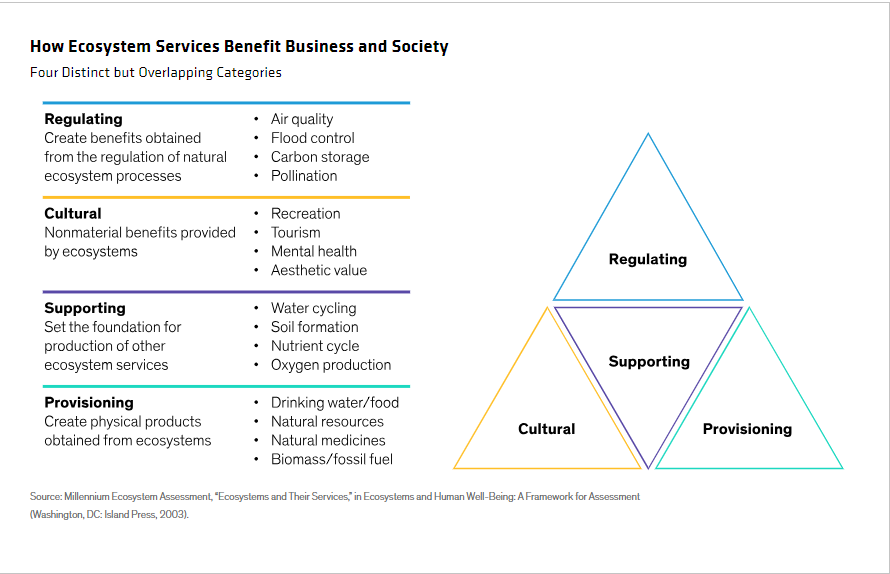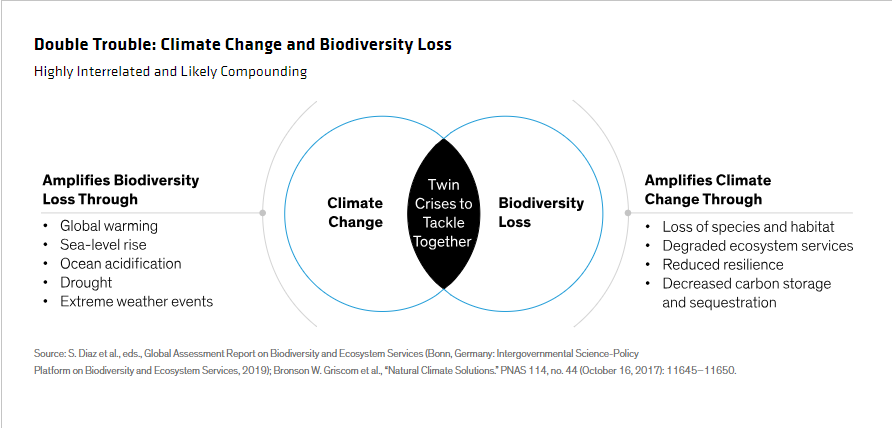Written by: Sara Rosner, Patrick O'Connell, CFA and David Tsoupros, CFA
From South Africa’s endangered black rhinoceros to the shrinking Amazon rainforest, threats to the variability of life on Earth are mounting. Protecting biodiversity—animals, plants and other living organisms, and the ecosystems they are part of—is vital to maintaining the health of our planet and the products, services and economic activity that sustain our daily life. Yet until recently, biodiversity hasn’t ranked highly among investors’ priorities.
This may seem surprising, given biodiversity’s importance as the living component of the natural world. Together with abiotic resources—the nonliving components of the natural world, such as land, water, air and minerals—biodiversity comprises natural capital, the world’s stock of natural assets.
Natural capital provides the building blocks that enable ecosystem services—the positive benefits that societies and economies derive from nature—to sustain life and create wealth. That’s why biodiversity loss alone could cost the global economy trillions of dollars in the coming years, in addition to trillions more related to climate change.
Biodiversity is, quite simply, the world’s life support system, the foundation from which nearly all goods and services are produced.
Web of Life: Biodiversity Risks Are Highly Complex
For many years, governments and investors have focused on the material impacts of climate change, with little consideration for the role of the natural world. But today there is a growing recognition of the high degree of interconnectivity and myriad feedback loops between climate change and nature—and a greater appreciation of the risks associated with biodiversity.
The interconnectedness within and across ecosystems makes biodiversity risk especially complex. Ecosystem services can be grouped into four interconnected categories: the regulation of natural ecosystem processes, such as pollination; the provisioning of physical products, including food; the cultural or nonmaterial benefits that arise from a harmonious relationship between people and their environments; and, most importantly, the supportive infrastructure of oxygen production, water and nutrient cycles, and soil formation, which makes all other ecosystem services possible (Display).

The idea of interconnectedness is important when considering the drivers of biodiversity loss. Changing land use (such as deforestation) and sea use has been one of the largest threats to biodiversity. According to the World Wildlife Fund, land conversion is the main reason for a 69% decline in wildlife populations (mammals, birds, amphibians, reptiles, and fish) since 1970.
But deforestation not only affects wildlife; it also impinges on climate. The Amazon rainforest, for example, currently absorbs 30% less carbon dioxide than it did in the 1990s due to deforestation to make way for cattle farms. Deforestation reduces the forest’s capacity to store and release moisture into the atmosphere.
This reduction in moisture from the Amazon has major implications for the global hydrological cycle—the processes of rain, evaporation, freezing and melting around the world—which in turn negatively affects more species’ habitats and changes the global climate. Deforesting a further 20% of the Amazon could release more than 90 billion tonnes of CO2 into the atmosphere—2.5 times more than annual global fossil fuel emissions.
There is a silver lining, because interconnectedness works both ways: tackling climate change and biodiversity loss in tandem can lead to twin wins. Steps taken to reduce deforestation in the Amazon, for example, may help to mitigate the speed and severity of climate change by creating additional carbon sinks for growing carbon flows.
The National Academy of Sciences in the US underscored the connection between nature and climate when it estimated that, in a below-2-degrees Celsius warming scenario, nature-based solutions such as green infrastructure and carbon sequestration and storage could carry out 37% of necessary carbon mitigation between now and 2030, and 20% between now and 2050.
In other words, tackling biodiversity loss and climate change is one route to resolving two systemic issues (Display).

Similarly, in our view, awareness of the links between biodiversity and climate risks may help investors develop valuable insights and investable opportunities for their portfolios through carbon credits, agricultural solutions, ecotourism, water management, green infrastructure and other nature-based solutions, to name just a few.
The web of risks becomes even more complex when other causes of biodiversity loss are considered. Land- and sea-use change and climate change are only two of the worst drivers. Others include direct exploitation, pollution and invasive species.
While changing sea and land use are currently ranked as the most destructive causes, these rankings may vary over time, adding another layer of complexity. Failure to abate climate change, for example, may lead to climate becoming the leading cause of biodiversity loss.
Investors face an urgent challenge in analyzing and managing these risks and opportunities. As biodiversity loss continues, the risks to companies and investment portfolios increase. And, as governments and regulators respond to biodiversity loss, the pressure builds on businesses and investors to engage with these issues, generating opportunities.
Helping Investors Rise to the Challenge
The challenge of analyzing and managing nature-related risks and opportunities is not insurmountable. Investors can take practical steps to engage with biodiversity risk by understanding its place in the broad ecological structure, its role in underpinning ecosystem services and how those services interact with each other in supporting life and economic activity.
From there, they can develop a framework for assessing companies’ biodiversity exposures—not just physical and transition risks, but also the economic and investment opportunities that can arise from actions taken to mitigate biodiversity loss and climate change. And, by applying appropriately designed conceptual frameworks and specialist data, biodiversity risk and opportunities can be calibrated at the sector and individual issuer levels and mapped to investor portfolios with the goal of unlocking better returns.
By using these approaches in an active strategy that combines fundamental research, third-party specialist knowledge and issuer engagement* and stewardship, investors can aim for meaningful long-term performance while helping to mitigate nature-related business and investment risks.
These actions alone won’t solve the biodiversity crisis, but they may help to create a world in which, one day, economies will behave more like ecosystems and less like invasive species.
Related: Is the “Vibe-Cession” for Us Consumers on Its Way Out?



